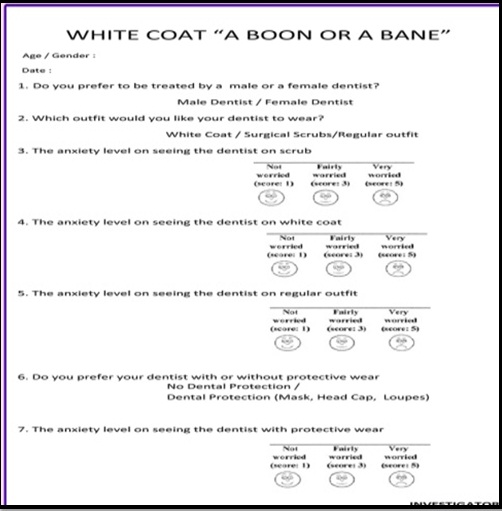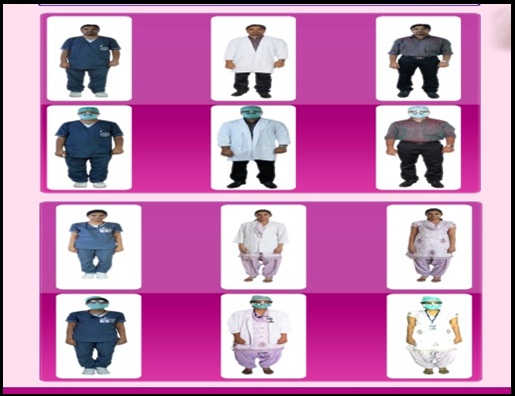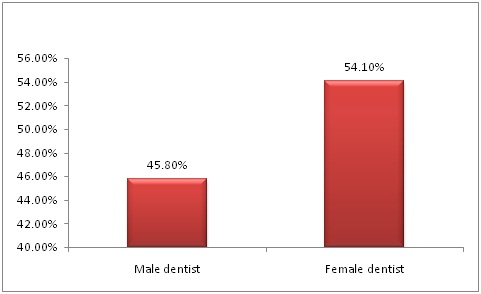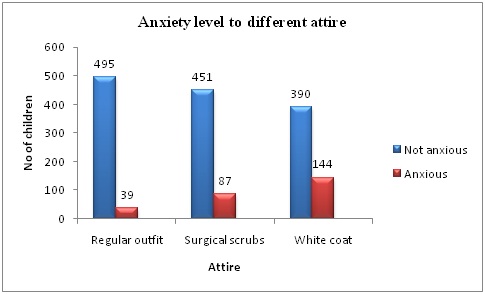In dental practice, young children do not co-operate for dental procedures due to the fear of dentist and the dental treatment. This remains as a major hindrance to deliver a good quality of dental treatment [1]. This anxious feeling in the child may arise either directly through acquisition or indirectly, transmitted through information [2]. In either way it affects the child’s behaviour in the dental set up. Friendly relationship and rapport between the child and the dentist is important for the key success of dental treatment and also to improve the quality of dental treatment.
As children develop an impression of their dentist prior to verbal communication based on their appearance, it is important to determine the positive and negative effects of dentist’s attire. The attire of the dentist still remains a topic of debate [3] and the choice of dentist’s attire influences patient’s view of the dentist.
Age is one of the major factors which influence the behaviour and co-operation of the child during dental treatment [4–6]. Around the age of 6 years, there is improvement in the child’s ability to resolve his/her own fears and as the age advances the child’s thinking process becomes more logical and the child understands others perspective [7]. Dental anxiety begins to reduce by the age of 6-7 years [8] and child’s reaction to dental treatment also varies as the age advances and Erikson considered the age group of 6-11 years as the age of mastery of skills [9].
Dentist’s attire has been a topic of interest as there is a constant variation in the children’s perception on their dentist’s attire. Various studies show that children have preference to white coat and formal outfit [1,10,11]. Most of these considerations may vary based on the age of the child.
Though several studies have assessed the preference of children towards dentist’s attire [1,10–16], they give an overall preference and the anxiety level of children towards dentist’s attire. However, literature lacks information regarding preference of dentist’s attire according to different age group of children. As there is a variation in preference level indicated in different studies [1,10–16], it is important to evaluate the children’s preference according to their age group and to get a clear picture of child’s preference according to different age group which was not illustrated earlier. In addition, it is important to assess their preference and anxious state in different environments, because dental environment remains a key factor to provoke anxious stimuli [17] and the child’s preference and anxiety level may vary in different environments. Surgical scrubs have been considered as a dress code of surgeons and its use is very less in the dental set up. Since, only few dental colleges and hospitals in India are using surgical scrubs as their regular attire in work place, it is important to assess children’s preference level towards surgical scrubs, as it is not a regular attire in all dental colleges and hospitals. So, the present study was conducted to assess the relationship between the age of the child and dentist attire such as white coat, surgical scrubs and regular outfit in two different environments that is, in dental environment and in school environment.
Materials and Methods
The study protocol received ethical approval from the institutional review board (srb/stpg 15/33) of Saveetha Dental College and the study was carried over for a period of 6 months. The study group was composed of children aged between 6-11 years. The present cross-sectional study was conducted in two different environments namely, the dental setup and school environment. In the dental set up, children were selected who visited the Department of Paediatric and Preventive Dentistry, Saveetha Dental College, Chennai, Tamil Nadu, India, for the first time. In the school environment, a personal interview was conducted by a single, qualified Paediatric dentist after receiving approval from the school administrator and from the child’s parents.
The inclusion criteria were that the child’s age should be between 6-11 years. The children with systemic illness, the children who required emergency dental management or the children who were called for reviews were excluded from the study.
Initially, a pilot study was conducted on 50 children in dental environment and 50 children in school environment, because there was no studies in the literature comparing the child’s preference of dentist attire at different age group and in different environments. During the pilot study, photographs were shown to children and the questionnaire was evaluated by the Paediatric dentist. Intra- examiner reliability was assessed (Kappa statistics > 0.8) by recalling the same children in the dental setup and visiting the same children in the school after a week and certain modifications were incorporated in the questionnaire, which were difficult to understand. According to the pilot study, the prevalence was
1. In school environment, 50% of children preferred white coat, 30% preferred surgical scrubs and 20% of children preferred regular outfit.
2. In dental environment, 46% of children preferred surgical scrubs, 40% of children preferred white coat and 14% of children preferred regular outfit.
The mean and standard deviation of the pilot study were 9.74±1.54 and 9.31±1.44 respectively. Sample size was calculated based on the mean and standard deviation values of the pilot study using G power (Version 3.1), Type I error of 5% and at 95% of power (1-β err prob). This gave an estimation of 522 children to be recruited. After increasing the sample size by 25% to compensate for attrition, the sample of 670 children was chosen. As few parents failed to give a written consent for the study, the final sample size was 534 at the end of the study. Due to age specific response encountered during the pilot study, the children were divided as younger (6-7 years), middle (8-9 years) and older age (10-11 years) groups based on their age and were involved in the study.
The questionnaire used in this study included seven items designed to assess the children’s preference and their anxiety level towards their dentists’ attire. Subjects were asked, do they prefer to be treated by a male or a female dentist, outfit they prefer, the anxiety level on seeing each outfit (White coat, Surgical scrubs, Formal attire), and the protective eye wear and its anxiety level. The anxiety level was evaluated using MCDAS (f) [18]. Photographs were shown and they were asked to choose between pictures to indicate their preference regarding the dentists’ gender, attire and protective wear.
The data from the questionnaire was coded and entered into the SPSS version 20.0 for the statistical analysis. Descriptive approach was used in the data analysis. Chi-square test was used to determine the relationship between different variables.
Results
Demographic data included 534 children, 270 boys and 264 girls in the age group between 6-11 years with the mean age of 8.44 years. The given questionnaire and photographs have been shown in [Table/Fig-1,2] and the gender preference of the dentist by children is depicted in [Table/Fig-3]. Of the 534 respondents, 45.8% of children preferred male dentist and 54.1% of children preferred female dentist.
Questionnaire to evaluate children’s preference and anxiety level.

Male and female dentist dressed in different attire.


Dentist gender to children gender preference is given in [Table/Fig-4]. Of the total 78.8% of boys preferred male dentist and only 21.1% of boys preferred female dentist. Similarly, 87.8% of girls preferred female dentist and 12.1 % of girls preferred male dentist. Gender to attire preference is depicted in [Table/Fig-5]. Of the total 41.1% of boys preferred white coat whereas only 31.8% of girls preferred the same. Preference level for surgical scrubs was high among girls (41.2%) and only 31.4% of boys preferred surgical scrubs. A 27.4% of boys and 26.8% of girls preferred regular outfit.
Gender to gender preference.
| Groups | Preference of dentist gender | p-value |
|---|
| Male dentist n (%) | Female dentist n (%) |
|---|
| Boys | 213 (78.8%) | 57 (21.1%) | <0.01* |
| Girls | 32 (12.1%) | 232 (87.8%) |
p value* <0.01- significant- Chi-square statistical test
Gender to attire preference.
| Groups | Attire preferred | p-value |
|---|
| White coat n (%) | Surgical scrubs n (%) | Regular outfit n (%) |
|---|
| Boys | 111(41.1%) | 85 (31.4%) | 74 (27.4%) | 0.035* |
| Girls | 84 (31.8) | 109 (41.2%) | 71(26.8%) |
*p value < 0.05-Significant -Chi square statistical test
Distribution of children according to their age group and the attire preferred is depicted in [Table/Fig-6]. There was a significant difference in the preference level of children for different attire (p=0.002).
Preference of attire based on different age groups.
| Age groups | Attire preference | p-value |
|---|
| Regular outfit % (n) | Surgical scrubs % (n) | White coat % (n) |
|---|
| 1 | 39% (77) | 28.9% (57) | 31.9% (63) | 0.002 ** |
| 2 | 20.3% (37) | 39.5% (72) | 40.1% (73) |
| 3 | 20% (31) | 41.9% (65) | 38% (59) |
**p value =0.002 - Highly significant -Chi-square statistical test
Pearson correlation (r) = +0.134
1-Younger age group (6-7years), 2-Middle age group (8-9 years), 3-Older age group (10-11 years)
Distribution of children based on their anxiety level to different attire is shown in [Table/Fig-7]. It shows that 495 children were not anxious to see their dentist in regular outfit. Similarly 451 children were not anxious to see their dentist in surgical scrubs and 390 children were not anxious about their dentist’s white coat. [Table/Fig-8] explains the anxiety level for each attire and protective eye wear among different age groups and it was not statistically significant (p>0.05).
Distribution of children based on their anxious and non-anxious level to different attire.

Anxiety level on seeing the dentist in different attire.
| Attire | Anxiety level | Age groups | p-value |
|---|
| 1 | 2 | 3 |
|---|
| White coat | Not worried | 155 | 129 | 106 | 0.171 |
| Fairly worried | 34 | 39 | 35 |
| Very worried | 8 | 14 | 14 |
| Surgical scrubs | Not worried | 162 | 157 | 132 | 0.267 |
| Fairly worried | 25 | 21 | 21 |
| Very worried | 10 | 4 | 2 |
| Regular outfit | Not worried | 187 | 169 | 139 | 0.302 |
| Fairly worried | 7 | 10 | 14 |
| Very worried | 3 | 3 | 2 |
| Protective eye wear | Not worried | 99 | 83 | 61 | 0.100 |
| Fairly worried | 64 | 71 | 73 |
| Very worried | 34 | 28 | 21 |
p-value > 0.05- Chi square statistical test
1-Younger age group (6-7years), 2-Middle age group (8-9 years), 3-Older age group (10-11years)
[Table/Fig-9] depicts the attire preference in two different environ-ments, in dental setup and school and it was statistically significant (p<0.001). [Table/Fig-10] explains the attire preference according to different age groups in different environments and it was highly significant in the older age group children (p<0.001).
Attire preference based on different environment.
| Environment | Attire preferred | p-value |
|---|
| White coat n (%) | Surgical scrubsn (%) | Regular outfit n (%) |
|---|
| Dental setup | 76 | 118 | 51 | 0.001 ** |
| School environment | 119 | 76 | 94 |
**p value <0.001-Highly significant -Chi square statistical test
Attire preference based on two different environment and three different age groups.
| Attire | Anxiety level | Age groups | p-value |
|---|
| 1 | 2 | 3 |
|---|
| 1 | Dental setup | 20 | 31 | 27 | 0.024* |
| School environment | 43 | 26 | 50 |
| 2 | Dental setup | 31 | 38 | 13 | 0.182 |
| School environment | 42 | 34 | 24 |
| 3 | Dental setup | 25 | 49 | 11 | 0.001** |
| School environment | 34 | 16 | 20 |
** p-value <0.001 -Highly significant, *p-value <0.05-Significant- Chi- square statistical test
1-Younger age group (6-7years), 2-Middle age group (8-9 years), 3-Older age group (10-11 years)
Discussion
The purpose of this study was to identify the children’s preference and their anxiety level towards their dentist attire and influence of environment towards their preference. This study provides the need for modification in the dentist attire according to patient’s age, which would improve the quality of dental visits and reduce the anxiety level of the children in dental office during subsequent dental visits.
The present study was evaluated by a single, qualified, Paediatric dentist, so that the risk of bias on the outcome measures could be minimized. The anxiety level was evaluated using MCDAS (f). The scale is a reliable and valid measure and children can easily respond to this faces rating scale [19]. Children with complex and additional needs can also communicate easily using this faces version of MCDAS (f) [18].
Children in this current study preferred dentist from the same gender. This finding is similar to the study done by Alsarheed et al., Mistry D et al., and Ellore VPK et al., [1,3,10]; however, the results were contradictory to the findings of Munevveroglu AP et al., who had stated that most of the children preferred to get treated by a female dentist [14]. Accordingly, it would be more appropriate to assign the patient to the similar gender dentist to improve the interaction between the child and the Paediatric dentist.
The results of this study suggest that there is a strong preference, among children, of their dentist’s attire and the protective eye wear worn by them. This study supports and provides a similar result obtained by the study conducted by Panda et al., who stated that, the children have strong preference and perception regarding their dentist’s attire [16].
Younger age group children preferred more of regular outfit without dental protection, which is similar to the study done by Kuscu et al., [11]. The reasons for their preference of regular attire includes, friendly appearance, casual outlook and not scary. Their anxious feeling towards white coat and surgical scrubs include bodily injury. Most of the children belonging to this age group were anxious on seeing their dentist with protective eye wear. This result is in agreement with the study done by Alsarheed et al., and Panda et al., who had reported that children did not prefer the use of protective wear [1,16].
Preference level from regular outfit towards white coat and surgical scrubs gradually shifted in the middle and older age group children. Their preference level towards white coat and surgical scrubs was significantly high in this age group (p=0.002). This variation in the preference level according to the child’s age was not described earlier. But their preference level towards protective eye wear was significantly low.
Middle age group children preferred more of traditional white coat. This finding is similar to the studies done by Alsarheed et al., Mistry D et al., Ellore VPK., Panda et al., and Brase et al., the results of these studies are in agreement with the present study [1,3,10,16,20]. Since, white coat is considered as a symbol of healing [1], this study suggests that children in this age group are more comfortable to see their dentist in white coat. Reasons for their preference for white coat includes, level of professionalism, preferred white color and improves the trust and confidence.
Similarly, majority of children in the middle and in the older age group preferred colored surgical scrubs. Ellore VPK et al., had stated that most of the children and parents in his study were least favoured for surgical scrubs and their preference level was high for child-friendly cartoon scrubs [10]. The reason for the preference of surgical scrubs in this study may be the colour of the scrub and most of the children stated the same as their preference. They also stated that scrubs gives a professional outlook and looks friendly too. Children in this age group were also anxious and did not preferred protective eye wear.
As dental environment plays an important factor to provoke the anxious response in children [17] and studies have evaluated the fear of children in dental setup with different settings such as decorated and undecorated dental clinic [14]. Studies were done to evaluate children’s preference of dentist’s attire in separate environments, either in dental environment [10] or in a school environment [1]. But there are no studies in the literature that compares the child’s preference and anxiety level to dentist’s attire in different environments. Thus, this study was conducted to find out any variation in the preference level of children towards dentist attire in different environment. The results suggests that, children preferred surgical scrubs in dental environment and their preference level for white coat was high in school environment. This clearly states the difference in preference level to different environment and the environmental influence as one of the factor in preferring dentist attire.
From the personal experience of the author during the interview with children, the author observed that, most of the children in younger age group were not able to explain or justify their reasons for dislike and anxiety, but responses and answers were similar among most of the children in this age group. Majority of children in the middle and older age group were able to justify the reason for attire preference. Our study asked children to indicate a preference and we also had a way of knowing the reason for their dislike.
Interestingly, children also indicated their preference for the accessories worn by the dentist, though it was not a part of our study. As stated by Panda et al., where children gave importance to the accessories worn by the dentist [16], further research can be done by accounting the preference level towards dentist’s accessories.
Dentist in private practice today do not wear white coat any longer. But in an institutional set up, it is important to wear white coat or surgical scrubs, to provide information or instructions authoritatively. But the present study indicates that the children under the age of 8 years preferred their dentist to wear regular outfit and children at or above the age of 8 years preferred white coat and surgical scrubs. So as a general practitioner or as a Paediatric dentist, we should take this into consideration and alteration in the attire for different age groups can improve the child-dentist relationship, so as to provide a good quality dental treatment.
Limitation
The limitation of our study is that, the photographs in our study included only of a younger looking male and female dentist. It is unclear whether children will give the same importance to these attires if the photographs showed older dentist’s.
Conclusion
Younger age group children preferred their dentist to wear regular outfit and middle and older age group preferred their dentist to wear white coat and surgical scrubs. White coat was the preference of choice by most of the children in school environment but their preference level towards surgical scrubs was high in dental environment.
p value* <0.01- significant- Chi-square statistical test*p value < 0.05-Significant -Chi square statistical test**p value =0.002 - Highly significant -Chi-square statistical testPearson correlation (r) = +0.1341-Younger age group (6-7years), 2-Middle age group (8-9 years), 3-Older age group (10-11 years)p-value > 0.05- Chi square statistical test1-Younger age group (6-7years), 2-Middle age group (8-9 years), 3-Older age group (10-11years)**p value <0.001-Highly significant -Chi square statistical test** p-value <0.001 -Highly significant, *p-value <0.05-Significant- Chi- square statistical test1-Younger age group (6-7years), 2-Middle age group (8-9 years), 3-Older age group (10-11 years)